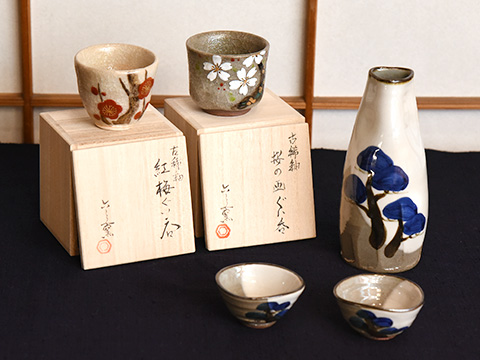Japanese Arts & Crafts
Handicrafts Sales

Hanami Koji street retains a strong traditional Kyoto atmosphere, and the owner of Kiku-Ume has carefully selected various handmade crafts such as small Japanese style objects and pottery for sale here.
Opening hours: 12:00~19:00
Closed: Every Wednesday and Japanese New Year
Introduction of Artists and Designers
Introduction of Artists and Designers

FUJIMOTO MIEKO

Born in Kyoto. Her mother was a kimono designer who made kimonos for Geisha and Maiko. She grew up under the influence of her mother.
After graduating from a short-term university, she studied formal design and then entered the fashion industry as a fashion designer, gaining experience over the course of 12 years. Later, she worked as an instructor in a dressmaking course and started her own business in 2010.
She is now the head of fathion design studio Kiwa Mieko, as creative artist she offers personal clothing customization services. She also owns original brand "Mieko Style", which sells handmade Japanese crafts.
She makes dresses and handmade bags using traditional Japanese kimono and obi materials. "A unique item from all over the world is dedicated to you, the only one in the world.

TANAKA HIROSHI

A traditional craftsman of Kyoyaki which is famous and Kiyomizu-yaki.
Born in Kyoto.
Owns a pottery making workshop in the Kiyomizu-yaki pottery complex in Kyoto's Yamashina area.
Also working at Kyoto Seika University as a pottery creator.

KOTOBUKI TOSHUN

Located in a corner of the Kiyomizu-yaki pottery complex, KotoBuki Toshun is dedicated to introducing the culture of Kiyomizu-yaki.
Besides making Kiyomizu-yaki, they also offer pottery classes.
The traditional paintings on the works made and sold are painted by the craftsmen delicately.
In the pottery class, you can paint teacups, mugs, and other mugs with your own hand and add your own ideas to create unique pieces.

SHOSA by NO NO Yes

- Japan Heart
The design is inspired by the "FUKUSA" fabric used to wrap the gifts for wedding ceremony.
The design incorporates the ancient paper folding technique "Origami", which is used to wrap gifts.
- Japan Leather
Japan Leather is tanned with great care using the world's rare pure vegetable tanning method. The product is made from one single piece of leather that is cut and folded without stitching to maximize the natural look of the leather, making it tough and durable.
- Japan Made -
The production process originates from Himeji, a leather producer that has been making leather goods for thousands of years and is known as a sacred place.
No sewing machines or other electric machines are used in the production, and all processes are done by hand by craftsmen.
From the beautiful shores of Himeji Castle, we deliver exquisite products to our customers and accompany them around the world.

KIYOMIZU ROKUBEY VIII

Rokubey VIII was born in Kyoto in 1954 as the eldest son of the seventh generation. After graduating from Waseda University's Faculty of Science and Engineering in 1979 with a degree in architecture, he entered the field of pottery making by studying windlass and glazing techniques at the Kyoto Prefectural Ceramist's Technical insitute and the Kyoto City Kyoto City Municipal institute of industrial Research.
In 1983, he began to design and produce pottery independently, and in the same year he won the Grand Prix of the Asahi Ceramic Art Exhibition '83. From the 1980s to the 1990s, he continued to improve his skills in pottery design and expression, and continued to receive a lot of attention. In the production method, he usually cuts the clay slabs according to the composition first, and then reassembles them. Appropriate gaps are also left to adjust the strength of the blank, or gravity is used for firing, and factors such as skewing or distortion are incorporated into the artistic creation.
After assuming the name of Kiyomizu Rokubey in 2000, he focuses on producing unique and distinctive artistic ceramic works.
In 2003 (Heisei 15), he was invited to become a professor at Kyoto University of Art and Design (renamed Kyoto University of the Art in 2020). While carrying out vigorous creative activities, he is also dedicated to mentoring the younger generation.
In 2005, he received the 2004 the ceramic society of Japan prize and is one of the leading figures in contemporary Japanese ceramic art.

Rokubei gama

The Rokubey gama was first established in Gojozaka, Kyoto in 1771 by the first generation of Rokubey Kiyomizu. Over the next 250 years, successive generations of the family inherited their skills and created a unique artistic style, resulting in a steady stream of exquisite works.
Kiyoroku Toei co.,Ltd. (now Kiyoroku Co., Ltd.) was established by the sixth generation of Rokubey Kiyomizu to run the company. Today, under the supervision of the current family head, Rokubey Kiyomizu VIII, Rokubey gama incorporate the traditional art of kyoyaki into contemporary lifestyles, producing a variety of objects such as tableware, floral objects, ornaments, and tea pottery.

Mieko Yagi

| 1996 | Graduated with a major in Arts from Nara University of Education. |
| 2002 | Completed the Design Course at the Kyoto Prefectural Advanced Technical School of Ceramics. |
| Engaged in work at a painting studio. | |
| 2011 | Industry Technicians Training Program. |
| 2013 | Part-time lecturer for the Ceramics Course in the Kyoto City Traditional Industry Technicians Training Program. |
| Opened a business in Higashiyama Ward, Kyoto City. | |
| 2015 | Solo exhibition at the Kyoto Ceramic Center. |

Kiku-Ume's original "Gion Koji" series

A certain set of traditional Japanese color is chosen to express the impression of the names of the various paths in the Gion area of Kyoto.
The dye has been extracted from the natural vegetable, and the colors are soft, simple and elegant.
The products can be used for daily life or as a gift for friends and family.
Kiku-Ume's original "Gion Koji" series invites you to experience the unique charm of each little streetin Gion, led by Hanami Koji street.